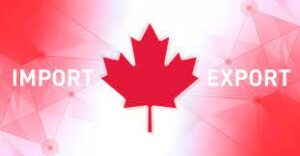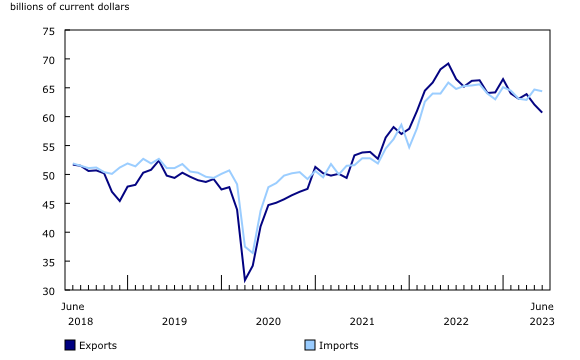The recent unionized strike by the B.C. Port workers had an effect on Canada’s Balance of Payments(BOP). In June, Canada’s merchandise exports decreased 2.2%, while imports were down 0.5%. As a result, Canada’s merchandise trade deficit with the world widened from $2.7 billion in May to $3.7 billion in June.

Recent port disruptions and international trade statistics
Strike at British Columbia marine port terminals
A port strike that significantly affected activity at British Columbia marine terminals began on July 1 and disrupted regular operations for more than 13 days. Canada’s international merchandise trade, especially with Asian countries, relies heavily on these ports to move goods. As a result of the strike, impacts on Canadian merchandise trade activity are anticipated for the reference month of July, in particular for containerized shipments. Statistics for the July reference month will be published on September 6.
In 2022, 9.2% of Canada’s total exports by value were shipped through British Columbia via marine transportation. For imports, 5.0% of the total value was cleared by B.C. marine ports in 2022. Over half of exports through B.C. ports were resource-based goods, ranging from mined commodities such as coal and potash to agricultural and forestry products, including wheat, canola and pulp and paper. Many of these goods are shipped in bulk, and are expected to be less impacted by strike activity in July. Imported goods arriving through B.C. ports included many finished consumer products as well as intermediate goods used in various industries.

International trade statistics do not include in-transit shipments, which reflect shipments between two countries that rely in part on a third country’s transportation infrastructure—for instance, cargo from overseas that is off-loaded at a B.C. port and then transported directly to the US by road or rail. As is consistent with international standards, in-transit shipments are excluded from Canadian International Merchandise Trade statistics. Among other factors, this may give rise to differences between the official trade data and the dollar value estimates of trade being reported in other media outlets and port operation authorities.
Severe flooding in Nova Scotia
Significant rainfall on July 21 led to flooding that damaged a section of the rail line that serves the port of Halifax. In 2022, the Halifax marine port cleared 1.4% of Canada’s total merchandise import value. In the same year, 0.8% of total exports were shipped from this port by water. The rail disruption caused by the flooding in July 2023 limited the ability of goods to travel further inland, and while marine terminals continued to operate normally, this could have an impact on merchandise trade activity. Rail service to the port had resumed by the end of July.
Merchandise exports decline for the second consecutive month
Following a 3.0% decrease in May, total exports were down 2.2% in June, with 9 of the 11 product sections posting declines. Total exports in real (or volume) terms fell 1.1% in June. As for export prices, they declined for the 11th time in the past 12 months. From June 2022 to June 2023, total export prices decreased 14.2%. However, during the same period, the value of total exports declined 12.3%, meaning that exports in real terms in fact increased.
Exports of metal and non-metallic mineral products decreased 8.0% in June, mainly because of lower exports of un-wrought gold, silver, and platinum group metals, and their alloys (-18.3%). Following high levels observed in April and May, exports of un-wrought gold declined sharply in June, primarily because of the decline in gold shipments to the United States and Hong Kong. This decline was the result of both lower exports of refined gold and decreased gold asset transfers in the banking sector.
Several other product sections had similar contributions to the decline in exports in June, mainly because of lower volumes. This includes exports of industrial machinery, equipment and parts (-5.0%), which decreased in part because of the decline in exports of parts of industrial machinery and equipment (-9.6%); exports of basic and industrial chemical, plastic and rubber products (-5.7%); and exports of farm, fishing and intermediate food products (-4.4%), which decreased notably because of the decline in exports of canola (-42.4%) and intermediate food products (-15.0%).
Imports of energy products and consumer goods decline, while imports of gold increase
After rising 3.0% in May, total imports decreased 0.5% in June. While 7 of the 11 product sections posted declines, these were largely offset by the increase in imports of un-wrought gold. In real (or volume) terms, imports were up 0.9%.
Imports of energy products were down 13.0% in June, a fifth decrease in 2023. Imports of refined petroleum energy products (-17.0%) posted the largest decline, mainly because of weaker imports of motor gasoline. Imports of motor gasoline increased significantly in June 2022, and this type of variation did not repeat in June 2023. After rising 23.2% in May, imports of crude oil (-9.5%) also contributed to the decline in June, mainly on decreases in imports from Saudi Arabia and Nigeria.
Imports of consumer goods were down 1.9% in June, largely because of lower imports of pharmaceutical products (-7.2%). These imports have shown significant variations since early 2023, mainly because of imports of active pharmaceutical ingredients, which are used in the production of new medications. The medications produced are then often exported to other countries. Exports of pharmaceutical products rose 27.4% in June.
Imports of metal and non-metallic mineral products (+12.9%) posted a second consecutive strong monthly increase and partially offset the overall decrease in imports in June. As in the previous month, imports of unrought gold, silver, and platinum group metals, and their alloys (+73.9%) contributed the most to the gain. While imports of silver drove the increase in May, imports of unrought gold increased the most in June, mainly on growth in gold asset transfers within the banking sector.

The deficit with countries other than the United States reaches an all-time high
In June, exports to countries other than the United States decreased 5.5%, while imports from these countries edged down 0.1%. As a result, Canada’s merchandise trade deficit with countries other than the United States rose from $10.4 billion in May to a record high of $11.2 billion in June.
In June, exports to the United States were down 1.2%, while imports decreased 0.7%. As a result, Canada’s trade surplus with the United States narrowed from $7.7 billion in May to $7.4 billion in June.

Quarterly nominal exports decrease more than imports
In the second quarter of 2023, exports decreased 3.5%, a fourth consecutive quarterly decline. Exports of energy products (-9.0%) and farm, fishing and intermediate food products (-19.5%) drove the quarterly decrease. Excluding these two product sections, exports edged up 0.2% in the second quarter.
After a slight increase of 0.1% in the first quarter, imports were down 0.3% in the second quarter. The decrease in imports of energy products (-15.7%) and industrial machinery, equipment and parts (-4.6%) was partly offset by the rise in imports of motor vehicles and parts (+5.6%) and metal and non-metallic mineral products (+10.5%).
In real terms, quarterly imports increase, while exports decrease
In real terms (calculated using chained 2012 dollars), exports fell 0.4% in the second quarter of 2023. Real exports of farm, fishing and intermediate food products (-14.8%) contributed the most to the decline. This decrease was partly offset by the increase in exports of motor vehicles and parts (+5.6%).
Real imports were up 0.9% in the second quarter; this increase occurred after three consecutive quarterly declines. Imports of metal and non-metallic mineral products (+15.4%) and motor vehicles and parts (+5.3%) increased the most in the second quarter.
Revisions to May merchandise export and import data
Imports in May, originally reported at $65.0 billion in the previous release, were revised to $64.7 billion in the current reference month. Exports in May, originally reported at $61.5 billion in the previous release, were revised to $62.0 billion in the current reference month’s release.
Monthly trade in services
In June, monthly service exports increased 0.4% to $14.7 billion. Meanwhile, service imports were down 0.2% to $15.7 billion.
When international trade in goods and services are combined, exports decreased 1.7% to $75.4 billion in June, while imports decreased 0.4% to $80.1 billion. As a result, Canada’s trade balance with the world went from a deficit of $3.8 billion in May to a deficit of $4.7 billion in June.
Note to readers
Merchandise trade is one component of Canada’s international balance of payments (BOP), which also includes trade in services, investment income, current transfers, and capital and financial flows.
International trade data by commodity are available on both a BOP and a customs basis. International trade data by country are available on a customs basis for all countries and on a BOP basis for Canada’s 27 principal trading partners (PTPs). The list of PTPs is based on their annual share of total merchandise trade—imports and exports—with Canada in 2012. BOP data are derived from customs data by adjusting for factors such as valuation, coverage, timing, and residency. These adjustments are made to conform to the concepts and definitions of the Canadian System of National Accounts.








